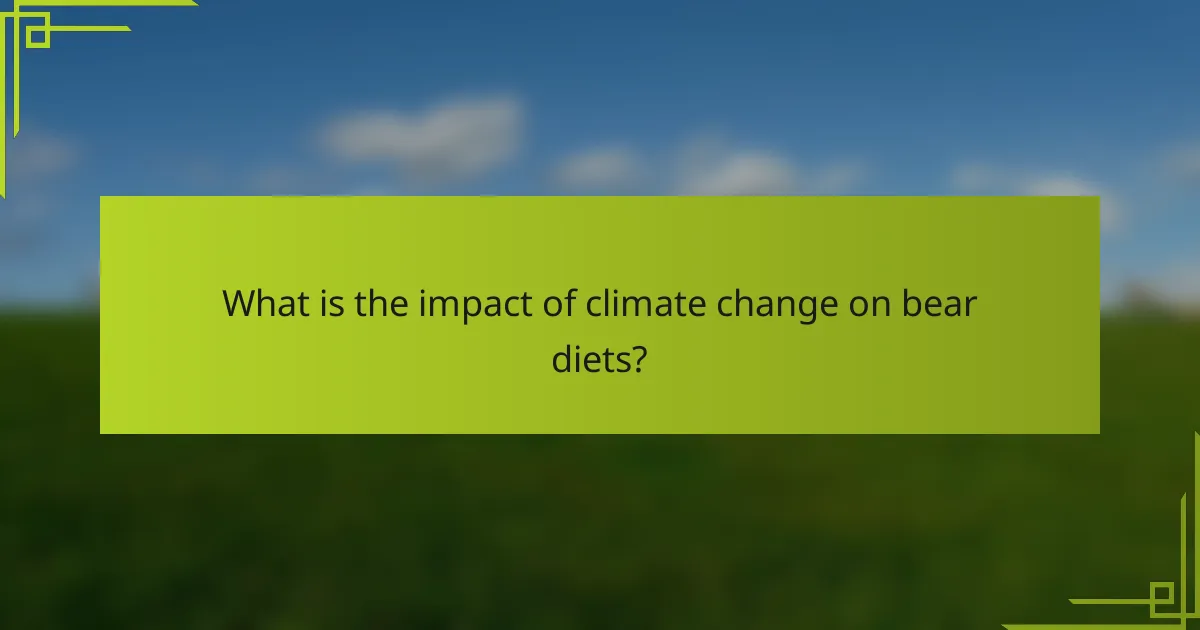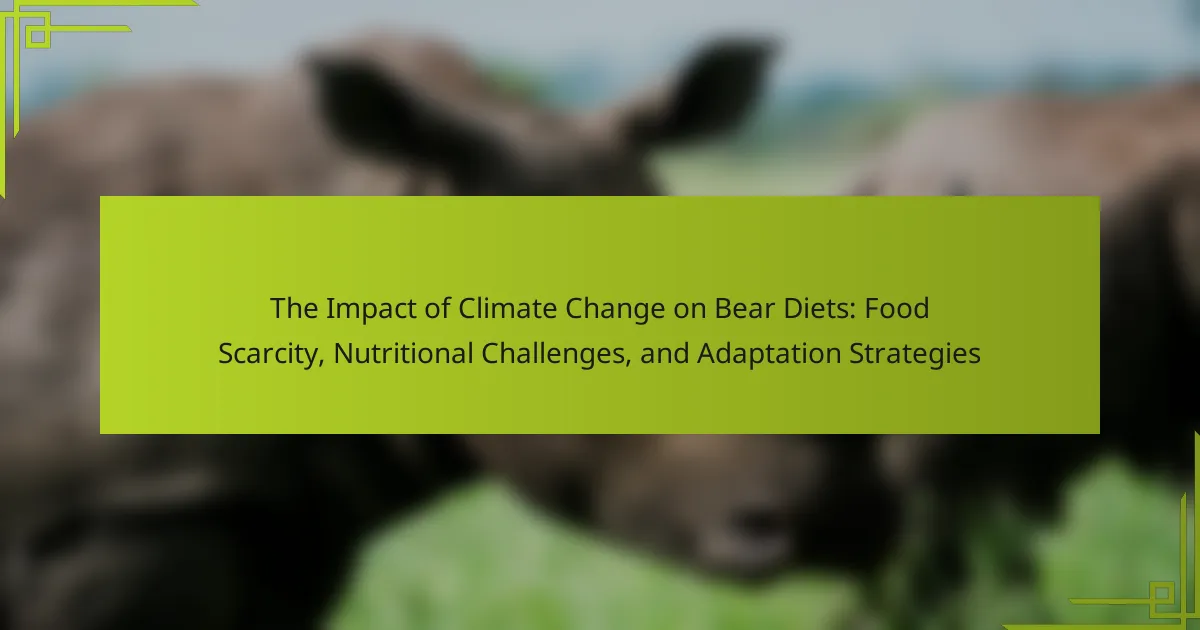Climate change is significantly affecting bear diets by altering food availability and nutritional quality. Rising temperatures disrupt the growth patterns of essential plants, causing mismatches between blooming periods and bear foraging times. For polar bears, decreased sea ice limits access to marine food sources, leading to food scarcity and increased competition among bears. These challenges result in changes to foraging behavior, diet diversification, and nutritional difficulties. Adaptation strategies are necessary for bears to survive in this changing environment.

What is the impact of climate change on bear diets?
Climate change significantly impacts bear diets by altering food availability and nutritional quality. Rising temperatures affect the growth patterns of plants that bears rely on for sustenance. For example, earlier springs can lead to mismatches between plant blooming and bear foraging times. Additionally, decreased sea ice affects the availability of marine food sources for polar bears. Studies indicate that food scarcity can lead to increased competition among bears. This competition may result in changes to foraging behavior and diet diversification. Bears may also experience nutritional challenges due to the decline in preferred food sources. These shifts necessitate adaptation strategies for survival.
How does climate change affect food availability for bears?
Climate change reduces food availability for bears by altering their habitats and food sources. Warmer temperatures and changing precipitation patterns affect the growth of vegetation. This impacts the availability of berries, nuts, and other plant-based foods that bears rely on. Additionally, climate change influences the migration patterns of salmon, which are crucial for bear diets. Research shows that these changes can lead to food scarcity during critical feeding periods. For example, the decline in salmon populations in some regions has been linked to rising water temperatures. Consequently, bears may face nutritional challenges due to limited food options.
What specific food sources are becoming scarce due to climate change?
Specific food sources becoming scarce due to climate change include fish, berries, and nuts. Rising temperatures affect fish habitats, leading to reduced populations. Changes in precipitation patterns impact berry production, decreasing their availability. Additionally, warmer winters can disrupt nut-bearing trees, resulting in lower nut yields. These changes threaten the diets of bears and other wildlife dependent on these food sources.
How does the seasonal availability of food change with climate shifts?
Climate shifts alter the seasonal availability of food by affecting temperature and precipitation patterns. Warmer temperatures can lead to earlier plant blooming and fruiting. This shift can disrupt the timing of food availability for animals. Changes in precipitation can affect crop yields and natural food sources. For example, droughts can reduce the growth of vegetation. Additionally, altered climate conditions can impact migration patterns of animals. These changes can lead to mismatches between food supply and animal feeding times. Research shows that many species are experiencing shifts in their foraging behavior due to these climate changes. Such disruptions can create nutritional challenges for animals, including bears, that rely on seasonal food sources.
What nutritional challenges do bears face as a result of climate change?
Bears face significant nutritional challenges due to climate change. Altered ecosystems impact the availability of their food sources. For example, reduced plant growth limits access to berries and other vegetation. Warmer temperatures may also shift the timing of food availability, disrupting feeding patterns. Changes in precipitation affect the growth of aquatic plants and fish populations. These factors lead to decreased body condition and reproductive success in bears. Research shows that food scarcity can increase competition among bear populations. Overall, climate change directly threatens the nutritional health of bear species.
How does food scarcity influence bear health and nutrition?
Food scarcity negatively influences bear health and nutrition. Limited food availability leads to malnutrition in bears. Malnourished bears experience weakened immune systems. This makes them more susceptible to diseases. Food scarcity also affects reproductive success. Female bears may have fewer healthy cubs. Additionally, bears may change their foraging behavior. They may travel longer distances in search of food. This increased energy expenditure can lead to further health issues. Studies show that food scarcity correlates with increased mortality rates in bear populations.
What are the long-term effects of inadequate nutrition on bear populations?
Inadequate nutrition leads to significant long-term effects on bear populations. Bears suffering from poor nutrition often experience decreased reproductive success. This results in fewer cubs being born and lower survival rates for those cubs. Additionally, inadequate nutrition can cause weakened immune systems. Weaker immune systems make bears more susceptible to diseases and parasites. Long-term food scarcity can also lead to changes in behavior. Bears may become more aggressive in search of food, impacting human-bear interactions. Furthermore, malnutrition can result in reduced body size and health over generations. Studies show that nutritional stress can affect population dynamics and overall ecosystem health.
How are bears adapting their diets in response to climate change?
Bears are adapting their diets in response to climate change by shifting their food sources. As temperatures rise, traditional food sources like berries and salmon are becoming less available. Bears are increasingly consuming alternative foods, such as human food waste and agricultural crops. This adaptation helps bears meet their nutritional needs despite changing environmental conditions. Research indicates that bears are expanding their foraging ranges to find new food sources. Additionally, some species of bears are altering their foraging behaviors to take advantage of seasonal food availability. These dietary changes are essential for their survival in a rapidly changing climate.
What new food sources are bears incorporating into their diets?
Bears are incorporating new food sources such as human food waste and agricultural crops into their diets. As natural food sources become scarce due to climate change, bears adapt by seeking alternative nutrition. Research indicates that bears are increasingly foraging in urban areas for discarded food. They also consume more crops like corn and berries from farms. This shift is driven by the decline of traditional food sources like salmon and nuts. Studies show that bears’ reliance on these new sources can lead to increased human-bear conflicts. These adaptations highlight the impact of environmental changes on bear behavior and diet.
How do behavioral changes in bears reflect dietary adaptations?
Behavioral changes in bears indicate their dietary adaptations. As food availability fluctuates due to climate change, bears modify their foraging habits. For instance, they may increase their range to find alternative food sources. This behavior is evident in species like the polar bear, which has been observed traveling longer distances due to shrinking sea ice.
Additionally, bears may alter their feeding times to coincide with peak food availability. Research shows that black bears change their activity patterns based on the seasonal availability of berries and nuts. These adaptations help bears maintain their energy balance in the face of food scarcity.
Moreover, bears exhibit changes in social behavior, such as increased competition for food resources. This competition can lead to more aggressive interactions among bears as they seek limited food supplies.
Overall, these behavioral adaptations serve as a response to dietary needs shaped by environmental changes.
What strategies can be implemented to support bear diets amid climate change?
Implementing habitat restoration is crucial to support bear diets amid climate change. Restoring natural habitats enhances food availability for bears. This includes reforestation and wetland restoration efforts. These strategies can improve the growth of plants bears rely on for nutrition.
Creating wildlife corridors facilitates bear movement between food sources. This allows bears to access diverse food options as climate conditions change. Monitoring food sources helps identify shifts in bear diets. Research indicates that bears adapt their diets based on food availability.
Developing community-based conservation programs raises awareness about bear needs. Engaging local communities can lead to sustainable practices that benefit bear habitats. These strategies collectively aim to mitigate the impacts of climate change on bear diets.
How can conservation efforts help mitigate food scarcity for bears?
Conservation efforts can help mitigate food scarcity for bears by preserving their natural habitats. Protecting forests and wetlands ensures that bears have access to essential food sources like berries and fish. Habitat restoration enhances the availability of these food resources. Conservation programs can also regulate hunting and reduce human-bear conflicts. This allows bear populations to thrive and maintain their ecological roles. Research shows that areas with strong conservation measures have healthier bear populations. For example, the Yellowstone National Park has seen an increase in bear numbers due to effective conservation strategies. Overall, targeted conservation efforts are crucial for sustaining bear food sources in a changing climate.
What role do habitat protection and restoration play in supporting bear diets?
Habitat protection and restoration are crucial for supporting bear diets. These efforts ensure the availability of natural food sources. Bears rely on diverse habitats for foraging. Healthy ecosystems provide berries, nuts, and fish that are essential for their nutrition.
Habitat degradation reduces food options for bears. Deforestation and urban development disrupt their feeding grounds. Studies show that protected areas have higher bear populations due to abundant food resources.
Restoration projects can enhance food availability. Replanting native vegetation supports the growth of food sources. This, in turn, sustains bear populations and promotes biodiversity. Therefore, effective habitat management directly influences bear diet quality and availability.
What can we learn from the impact of climate change on bear diets?
Climate change significantly alters bear diets, impacting their food sources and nutritional intake. Bears rely on seasonal food availability, which shifts due to changing temperatures and weather patterns. For instance, the earlier onset of spring affects plant growth and the timing of berry production. Research indicates that bears may face food scarcity as their traditional foraging periods shorten. Additionally, climate change can lead to habitat loss, further limiting access to food. Studies show that bears are adapting by diversifying their diets, but this may not meet their nutritional needs. Overall, understanding these changes helps in conservation efforts and managing bear populations effectively.
How can understanding bear dietary changes inform broader ecological strategies?
Understanding bear dietary changes can inform broader ecological strategies by highlighting the impacts of climate change on food availability. Bears adapt their diets based on seasonal food sources, which are affected by temperature and precipitation changes. For instance, shifts in berry production due to warming can lead to nutritional deficiencies in bears. These dietary changes can indicate broader ecosystem health and biodiversity shifts. Monitoring bear diets helps predict the effects of climate change on other species within the same habitat. This information can guide conservation efforts and habitat management strategies. By recognizing the interconnectedness of species and their food sources, effective ecological strategies can be developed to mitigate climate impacts.
What best practices can be adopted to protect bear populations in changing climates?
Implementing habitat protection is essential for safeguarding bear populations in changing climates. Preserving natural habitats ensures bears have access to food and shelter. Establishing wildlife corridors allows bears to migrate and adapt to climate shifts. Monitoring bear health and populations helps identify stressors from climate change. Educating communities about bear conservation fosters coexistence and reduces human-bear conflicts. Supporting sustainable land-use practices maintains ecological balance. Researching climate impacts on bear diets informs adaptive management strategies. Collaboration with conservation organizations enhances effective protection efforts.
The main entity of this article is the impact of climate change on bear diets. The article examines how climate change alters food availability and nutritional quality for bears, leading to food scarcity and increased competition among populations. It highlights specific food sources that are becoming scarce, such as fish, berries, and nuts, and discusses the nutritional challenges bears face as a result. Additionally, the article explores how bears are adapting their diets by incorporating new food sources and the importance of habitat protection and restoration in supporting bear populations amid these changes. Key strategies for conservation and understanding the broader ecological implications of these dietary changes are also addressed.
